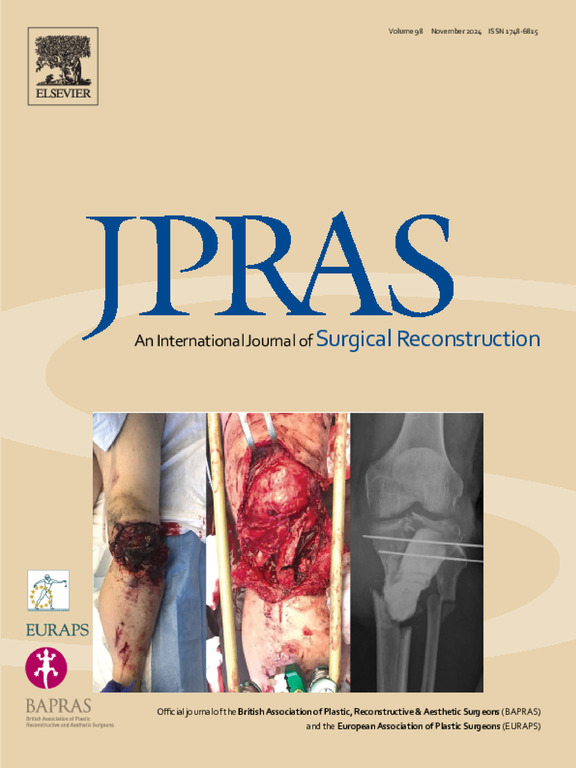Muscle versus fasciocutaneous flaps in fracture healing: A scoping review of basic science evidence
IF 2
3区 医学
Q2 SURGERY
Journal of Plastic Reconstructive and Aesthetic Surgery
Pub Date : 2025-06-24
DOI:10.1016/j.bjps.2025.06.009
引用次数: 0
Abstract
Background
Open extremity fractures with extensive soft tissue damage may require reconstruction with a soft tissue flap. While either muscle or fasciocutaneous flaps may be used, clinical studies have not definitively determined which results in lower infection rates. Therefore, we aimed to review the basic science literature on muscle and fasciocutaneous flaps to identify translational evidence supporting the use of one flap type over another for extremity reconstruction.
Methods
We conducted a scoping review of PubMed, Embase, Scopus, and Web of Science to identify non-clinical studies of soft tissue reconstruction for fractures or other osseous defects. Outcomes of interest included vascularity, infection, and biomechanical strength, as well as the molecular and cellular characteristics of the healed bone.
Results
We included 19 studies. Eleven studies reported exclusively on muscle flaps, and 8 studies compared muscle and fasciocutaneous flaps. Most studies modeled extremity fractures. Fractures managed with muscle flaps demonstrated enhanced angiogenesis, fewer infections, greater biomechanical strength, increased stem cell recruitment, and greater growth factor concentration compared to fasciocutaneous flaps.
Conclusions
The basic science literature suggests that muscle flaps are superior to fasciocutaneous flaps across several key outcomes pertaining to traumatic lower extremity fractures. These findings underscore the discrepancy between basic science and clinical evidence and emphasize the need for prospective clinical trials on flap reconstruction that control for injury severity.
肌肉与筋膜皮瓣在骨折愈合:基础科学证据的范围审查
背景:伴有广泛软组织损伤的开放性四肢骨折可能需要软组织瓣重建。虽然可以使用肌肉皮瓣或筋膜皮瓣,但临床研究尚未明确确定哪一种可降低感染率。因此,我们旨在回顾有关肌肉和筋膜皮瓣的基础科学文献,以确定支持使用一种皮瓣类型而不是另一种皮瓣用于四肢重建的转化证据。方法:我们对PubMed、Embase、Scopus和Web of Science进行了范围综述,以确定骨折或其他骨缺损的软组织重建的非临床研究。结果包括血管、感染、生物力学强度,以及愈合骨的分子和细胞特征。结果纳入19项研究。11项研究专门报道了肌肉皮瓣,8项研究比较了肌肉和筋膜皮瓣。大多数研究模拟了四肢骨折。与筋膜皮瓣相比,用肌肉瓣处理骨折可增强血管生成、减少感染、提高生物力学强度、增加干细胞募集和提高生长因子浓度。结论基础科学文献表明,在创伤性下肢骨折的几个关键预后方面,肌肉皮瓣优于筋膜皮瓣。这些发现强调了基础科学和临床证据之间的差异,并强调了对皮瓣重建进行前瞻性临床试验以控制损伤严重程度的必要性。
本文章由计算机程序翻译,如有差异,请以英文原文为准。
求助全文
约1分钟内获得全文
求助全文
来源期刊
CiteScore
3.10
自引率
11.10%
发文量
578
审稿时长
3.5 months
期刊介绍:
JPRAS An International Journal of Surgical Reconstruction is one of the world''s leading international journals, covering all the reconstructive and aesthetic aspects of plastic surgery.
The journal presents the latest surgical procedures with audit and outcome studies of new and established techniques in plastic surgery including: cleft lip and palate and other heads and neck surgery, hand surgery, lower limb trauma, burns, skin cancer, breast surgery and aesthetic surgery.

 求助内容:
求助内容: 应助结果提醒方式:
应助结果提醒方式:


